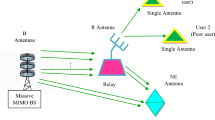Abstract
CRN is hyped as a powerful tool for advancing 5G networks that can significantly increase SE by allowing unlicensed users to access the inactive licensed spectra without interfering with licensed PUs. Moreover, CRN becomes more challenging due to the difficulty in accessing and detecting the channel. In this study, a Self-Upgraded Spider Monkey Optimization (SU-SMO)-based LSTM algorithm is used to predict the channel state. Additionally, it aims to carry out secure communication over the foreseen spectrum channels. The advanced encryption standard (AES) guarantees the security level of data frames to enable safe communication. Finally, an analysis was conducted to show how the model could be improved.
Access this chapter
Tax calculation will be finalised at checkout
Purchases are for personal use only
Similar content being viewed by others
Abbreviations
- Acronym:
-
Description
- MSS:
-
Multi-Band Spectrum-Sensing
- M-AES:
-
Modified Advanced Encryption Standard
- VANET:
-
Vehicular Network
- CRSN:
-
Cognitive Radio Sensor Network
- ACD:
-
Auto-correlation-based Detector
- ROC:
-
Receiver Operating Characteristics
- CR:
-
Cognitive Radio
- LSTM:
-
Long Short-Term Memory
- Pus:
-
Primary Users
- DBN:
-
Deep Belief Network
- MHTP:
-
Multichannel Hidden Terminal Problem
- ProMAC:
-
Proactive Medium Access Control protocol
- APS-MAC:
-
Adaptive Preamble Sampling-based MAC
- CRV:
-
Cognitive Radio for VANET
- CTS:
-
Clear To Send
- MME:
-
Maximum–Minimum Eigen value detectors
- DCNN:
-
Deep Convolutional Neural Network
- SNR:
-
Signal-To-Noise Ratio
- CS-GOA:
-
Cuckoo Search-Grasshopper Optimization Algorithm
- SM:
-
Spider Monkey
- RARE:
-
SpectRum-Aware cRoss-layEr
- MPC:
-
Model Predictive Control
- SUs:
-
Secondary Users
- MA:
-
Multiple Access
- MAC:
-
Medium Access Control
- SVD:
-
Singular Value-based Detector
- SDR:
-
Software Defined Radio
- CFD:
-
Cyclostationary Feature-based Detector
- RTS:
-
Request To Send
- CRN:
-
Cognitive Radio Networks
- FMAC:
-
Fairness-based MAC
- ED:
-
Energy Detector
- SE:
-
Spectrum Efficiency
- ECC:
-
Elliptic Curve Cryptography
- RSA:
-
Rivest–Shamir–Adleman
- DSA:
-
Dynamic Spectrum Access
References
Deka SK, Sarma N (2017) Opportunity prediction at MAC-layer sensing for ad-hoc cognitive radio networks. J Netw Comput Appl 82:140–151
Cao X, Song Z, Yang B (2018) Multi-slot reservation-based multi-channel MAC protocol for dense wireless ad-hoc networks. IET Commun 12(10):1263–1271
Rajput RS, Gupta R, Trivedi A (2020) An adaptive covariance matrix based on combined fully blind self adapted method for cognitive radio spectrum sensing. Wireless Pers Commun 114:93–111. https://doi.org/10.1007/s11277-020-07352-9
Liu S, Han B, Peng W (2018) A polling-based traffic-aware MAC protocol for centralized full-duplex wireless networks. IEEE Access 6:28225–28238
Mourougayane K, Amgothu B, Bhagat S, Srikanth S (2019) A robust multistage spectrum sensing model for cognitive radio applications. AEU-Int J Electronics Commun 110:152876
Le LB (2015) Design and optimal configuration of full-duplex MAC protocol for cognitive radio networks considering self-interference. IEEE Access 3:2715–2729
Xu X, Zhang N, Song H, Liu A, Zhao M, Zeng Z (2018) Adaptive beaconing based MAC protocol for sensor based wearable system. IEEE Access 6:29700–29714
Patel JB, Collins S, Sirkeci-Mergen B (2020) A framework to analyze decision strategies for multi-band spectrum sensing in cognitive radios. Phys Commun 42:101139
Cheng YC, Wu EH, Chen GH (2016) A decentralized MAC protocol for unfairness problems in coexistent heterogeneous cognitive radio networks scenarios with collision-based primary users. IEEE Syst J 10(1):346–357
Guirguis A, Karmoose M, Habak K, El-Nainay M, Youssef M (2018) Cooperation-based multi-hop routing protocol for cognitive radio networks. J Netw Comput Appl 110:27–42
Mansoor N, Islam AM, Zareei M, Vargas-Rosales C (2018) RARE: a spectrum aware cross-layer MAC protocol for cognitive radio ad-hoc networks. IEEE Access 6:22210–22227
Li A, Han G (2018) A fairness-based MAC protocol for 5G cognitive radio ad hoc networks. J Netw Comput Appl 111:28–34
Du M, Zheng M, Song M (2018) An adaptive preamble sampling based MAC protocol for cognitive radio sensor networks. IEEE Sensors Lett 2(1):1–4
Aloqaily M, Salameh HB, Al Ridhawi I, Batieha K, Othman JB (2020) A multi-stage resource-constrained spectrum access mechanism for cognitive radio IoT networks: time-spectrum block utilization. Futur Gener Comput Syst 110:254–266
Narayanan NS, Patnaik M, Kamakoti V (2016) ProMAC: a proactive model predictive control based MAC protocol for cognitive radio vehicular networks. Comput Commun 93:27–38
Patnaik M, Garg C, Roy A, Devanathan VR, Balachandran S, Kamakoti V (2015) Prowatch: a proactive cross-layer workload-aware temperature management framework for low-power chip multi- processors. ACM J Emerg Technol Comput Syst (JETC) 12(3)
Jha SC, Phuyal U, Rashid MM, Bhargava VK (2011) Design of OMC-MAC: an opportunistic multi-channel MAC with QoS provisioning for distributed cognitive radio networks. IEEE Trans Wireless Commun 10(10):3414–3425
Tobagi F, Kleinrock L (1975) Packet switching in radio channels: part II—the hidden terminal problem in carrier sense multiple-access and the busy-tone solution. IEEE Trans Commun 23(12):1417–1433
Author information
Authors and Affiliations
Corresponding author
Editor information
Editors and Affiliations
Rights and permissions
Copyright information
© 2023 The Author(s), under exclusive license to Springer Nature Singapore Pte Ltd.
About this paper
Cite this paper
More, K.P., Patil, R.A. (2023). Advanced Encryption Standard-Based Encryption for Secured Transmission of Data in Cognitive Radio with Multi-channels. In: Suma, V., Lorenz, P., Baig, Z. (eds) Inventive Systems and Control. Lecture Notes in Networks and Systems, vol 672. Springer, Singapore. https://doi.org/10.1007/978-981-99-1624-5_6
Download citation
DOI: https://doi.org/10.1007/978-981-99-1624-5_6
Published:
Publisher Name: Springer, Singapore
Print ISBN: 978-981-99-1623-8
Online ISBN: 978-981-99-1624-5
eBook Packages: Intelligent Technologies and RoboticsIntelligent Technologies and Robotics (R0)




